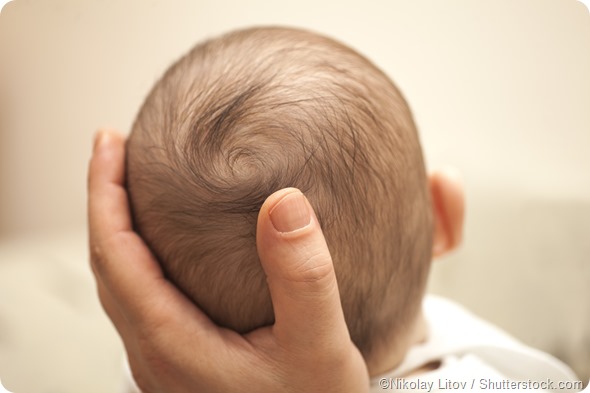What is a fontanelle?
The soft parts of the newborn baby’s skull are known as fontanelles. While there are six fontanelles found in the skull of a newborn, only two are commonly known. The one in the middle of the head, on the top portion is known as the Anterior fontanelle. It is shaped like a diamond and takes about a year to close. The one in the rear portion of the head is called the posterior fontanelle. It is triangular in shape and closes within a couple of months after birth.

How is a fontanelle formed?
The newborn human baby has a skull that consists of six different bones. These are also called cranial bones and include a frontal bone, an occipital bone, two parietal bones and two temporal bones. The six cranial bones are held in place by strong and flexible tissues known as sutures. Over a period of time these tissues tend to solidify, knitting the different bones of the cranium together to form the skull.
The six different fontanelles are formed along the lines of these six bones. Besides the anterior and posterior fontanelles, there are also two mastoid and two sphenoid fontanelles formed at birth. However these four fontanelles quickly seal up to form the skull leaving just the anterior and posterior fontanelles open for a few months longer.
Why do the fontanelles exist?
The primary reason for the existence of fontanelles is for child birth. The flexible and elastic sutures let the cranial bones overlap into a smaller and more compact form to allow it safe passage through the birth canal. The brain is protected from any pressure during the birth process and is not damaged due to the protection of the bones.
As the infant begins to hold his head up, rolls onto his stomach and even tries to sit up, the neck muscles are not developed enough to support the weight of the head. This results in a fair number of minor impacts to the head. Fontanelles are essential for the proper development of the baby’s brain as they are held together by the flexible sutures which protect the brain from the head impacts.
Also the skull bones or cranium grows along with the brain. This happens as the suture lines increase. By the age of two the baby’s skull would have achieved two third of its adult size. The bones continue to reposition themselves as growth adds new layers to the edge of the suture tissue. Finally by the second decade of the child’s life the brain reaches maximum size and the sutures get fused to the bone growth forming a whole skull structure.
How fontanelles help doctors
Doctors can actually trace the growth and development of the baby by feeling the cranial sutures. The fontanelle must feel firm and be flat when touched. Should there be a bulging of the fontanelle it may be indicative of an increase in pressure inside the brain. The swelling of the fontanelle could be due to an infection of the membrane covering the brain. This condition is also known as meningitis and can be harmful to the normal development of the child.
The bulge may be caused by a fluid build up inside the skull. The condition is called hydrocephalus. It is also possible that the fontanelle is sunken or shrunk inside. This could be an indication that the baby is dehydrated and needs more fluids. It can also be an indication of malnutrition in a newborn. Thus, the fontanelle can tell the health care provider a lot about the internal health of the baby.
Caring for the fontanelle
The shape of the baby’s skull is constantly changing for the first couple of months. This is due to the shifting of the cranial bones as the flexible sutures hold them in position. The two primary soft spots on the skull are located on top of the skull and behind the head. Since the bone there is yet to knit into a solid skull, these are vulnerable regions where the baby may get hurt.
The baby’s head should be handledcarefully at all times. When lifting the head of the baby the adult’s hand should support the neck and cover the posterior fontanelle. Also since the soft spots may not be enough to keep out the chill, it is advisable to cover the head of the baby with a soft cap when the temperature drops. That way both anterior and posterior fontanelles are afforded protection from the cold.
The skin of the skull should be kept clean to prevent infection. The cranial bones of most babies are sealed by the time they reach about 18 months of age. After that, the sutures will remain somewhat flexible to accommodate the continued growth of the brain and expansion of the skull.
References
- Medline Plus, Cranial Sutures, https://medlineplus.gov/ency/article/002320.htm
- Babycentre, Soft Spots, http://www.babycentre.co.uk/x552709/what-are-the-soft-spots-on-my-newborns-head
- American Family Physician, The Abnormal Fontanelle, http://www.aafp.org/afp/2003/0615/p2547.html
Further Reading
- All Baby Health Content
- Malrotation of the Gastrointestinal Tract
- Heat Rash in Babies
- Why Do Babies Cry?
- How to Stop a Baby Crying?
Last Updated: May 13, 2019

Written by
Cashmere Lashkari
Cashmere graduated from Nowrosjee Wadia College, Pune with distinction in English Honours with Psychology. She went on to gain two post graduations in Public Relations and Human Resource Training and Development. She has worked as a content writer for nearly two decades. Occasionally she conducts workshops for students and adults on persona enhancement, stress management, and law of attraction.
Source: Read Full Article
